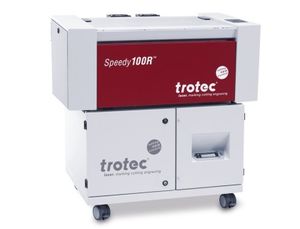Trotec Speedy 100R: Difference between revisions
m (→Materials) |
|||
| Line 75: | Line 75: | ||
* Engraving depth is varied through the laser power or the speed (energy per area unit principle) | * Engraving depth is varied through the laser power or the speed (energy per area unit principle) | ||
* For cutting, Hz settings (pulses per second) should be set to low, in particular if materials are flammable. | * For cutting, Hz settings (pulses per second) should be set to low, in particular if materials are flammable. | ||
* Vector lines are then color coded and for each color one can assign a cutting/engraving parameter. I.e. one could use "red" for cutting" and "greys" for engraving. A print job can include cutting, or engraving, or both. | |||
Read more in | Read more in | ||
Revision as of 16:47, 16 September 2016
Introduction
This page will document the Trotec Speedy 100R that TECFA (me) are in the process of acquiring - Daniel K. Schneider (talk) 18:10, 14 September 2016 (CEST)
Specifications of the 100R at TECFA
This system easily fits into an office and it just needs two electrical standard plugs.
Speedy 100R
- 50 W CO2 laser (Iradion tube)
- 610 x 305 working surface
- 180 cm/sec speed
- Box size: 982 x 780 x 457 mm
- 80 kg
- Air cooling
ATMOS Compact exhaust fan
- 815 x 675 x 555 mm
- 88kg
Official home page:
Outline of the workflow
Preparation steps
(0) Clean the lens (with a microfiber cloth ?)
(1) Switch the machine on
(2) Place work piece
- open cover
- Place piece into upper left-hand corner, against horizontal and vertical rules
(3a) Focus laser beam (manually)
- By default (for the mid-resolving lens) the beam is located 5.08 cm (2.0 in) below the lens.
- Position the processing head over the work piece
- Hang the focus tool on the external ring of the working head
- Then, move up (by little steps) the working table
(3b) Alternatively, focus laser beam with software
- Click the icon “focus laser” in the Trotec JobControl (make sure that material thickness, table height and lens type are OK !)
Create a graphic
- Any vector graphic will do, since jobcontrol will work from the print file
Preparing the print file
- Select File Print to access the printer driver
- In the Job Control software, specify
- engraving material
- engraving direction
- orientation of the work piece
- orientation of the plate
- Position the job on the plate with a double click
Establish Connectionin JobControl
- Verify
Exhaust Readyin Engraver Control (green arrow) in the Control of the JobControl
- Press
STARTbutton (green arrow) in Job Control.
Preparation of drawing
Principles:
- Input: Any 2D CAD or drawing file. For cutting, the stroke of the vectors should be 0.1mm or smaller.
- Engraving depth is varied through the laser power or the speed (energy per area unit principle)
- For cutting, Hz settings (pulses per second) should be set to low, in particular if materials are flammable.
- Vector lines are then color coded and for each color one can assign a cutting/engraving parameter. I.e. one could use "red" for cutting" and "greys" for engraving. A print job can include cutting, or engraving, or both.
Read more in
- Laser tutorial (EPFL, for a trotec speedy 500)
To learn which parameters are needed, look at published examples, for example:
- Do it yourself samples (Trotec)
- laser_cutter (tags on thingiverse, but most include little instructions)
Materials
A small CO2 laser cutter can cut or engrave a wide variety of materials, e.g. (some) plastics, wood, cardstock, textiles, cork, Delrin, Depron foam.
Never cut anything that includes chlorine. Its gas can badly damage your lungs and the machine. Without ventilation it even could kill. Other materials like ABS or HDPE can catch fire and/or melt.
Read more:
- Laser Cutter Materials (Hackerspace).
- Universal Laser Cutter Tutorial (MIT). Just read the intro.
Acrylic (plexi)
Acylic (Plexiglass) is probably the easiest material for cutting.
There are two different types of acrylic – cast and extruded. The cast acrylic becomes white or mat after engraving, the extruded acrylic remains clear. (Speedy 100 Manual, p. 43)
Cardstock and paper
Both cut well.
- Cardstock is "thick paper", e.g. like birthday greeting cards.
Some cardboard (the corrugated one?) on the other hand, can catch fire.
Plywood (contre-plaqué)
This is one of the most popular materials in education, since it is cheap and stable. However, it contains glue and may not cut as nicely as solid (non resinous) wood.
Polystyrene foams
Can catch fire and may be toxic. Special safety measures must be taken.
E.g. this is probably OK if you have a good ventilation system. It does not contain chlorine, see the MSDS
Cloth
Most "natural" fibers like felt, hemp or cotton cut well.
polyvinyl chloride (PVC)
- Very dangerous.
Links
- Migros Materials (local do-it-yourself shop)
- verre acrylique (500 x 250 x 5 = CHF 12.90)
